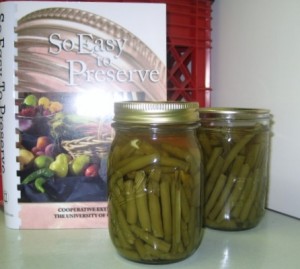 Do you know the difference between a water bath canning process and pressure canning process? If you are planning on canning as a way of preserving food this year, do your homework and find out the safe ways to process your food. Start by checking out the safe, reliable resources available from the National Center for Home Food Preservation, http://nchfp.uga.edu/. Resources such as the USDA Complete Guide to Home Canning and So Easy to Preserve both available at the above website have research tested recipes for canning at home.
Do you know the difference between a water bath canning process and pressure canning process? If you are planning on canning as a way of preserving food this year, do your homework and find out the safe ways to process your food. Start by checking out the safe, reliable resources available from the National Center for Home Food Preservation, http://nchfp.uga.edu/. Resources such as the USDA Complete Guide to Home Canning and So Easy to Preserve both available at the above website have research tested recipes for canning at home.
Proper canning techniques stop spoilage of food by using heat to destroy microorganisms. During the canning process, air is driven from the jar and a vacuum is formed as the jar cools and seals, preventing microorganisms from entering and re-contaminating the food.
Acids in food such as fruits and pickled products or sugar in jams and jellies protect against the growth of some microorganisms. It is safe to can these foods in a water bath canner which uses a boiling water process at 212 degrees Fahrenheit (F). But with low-acid foods, such a vegetables, meat, poultry and fish, a pressure canner must be used to raise the temperature to 240 or 250 degrees F in order to destroy Clostridium botulinum, the bacterium that causes botulism food poisoning. The exact time needed for processing depends on the kind of food being canned, the way it is packed in jars, and the size of jars. When you mix low-acid and high-acid foods, assume the mixture remains low-acid.
Tomatoes, once considered an acidic food, have been tested to be low acid so to safely can them in a water bath canner, an acid in the form of lemon juice or citric acid must be added.
For more information on water bath and pressure canning, check out:
Canning Basics http://go.osu.edu/canbasics
Basics for Canning Fruits http://go.osu.edu/canningfruit
Basics for Canning Vegetables http://go.osu.edu/canningveg
Basics for Canning Meat, Poultry and Game http://go.osu.edu/canningmeat

